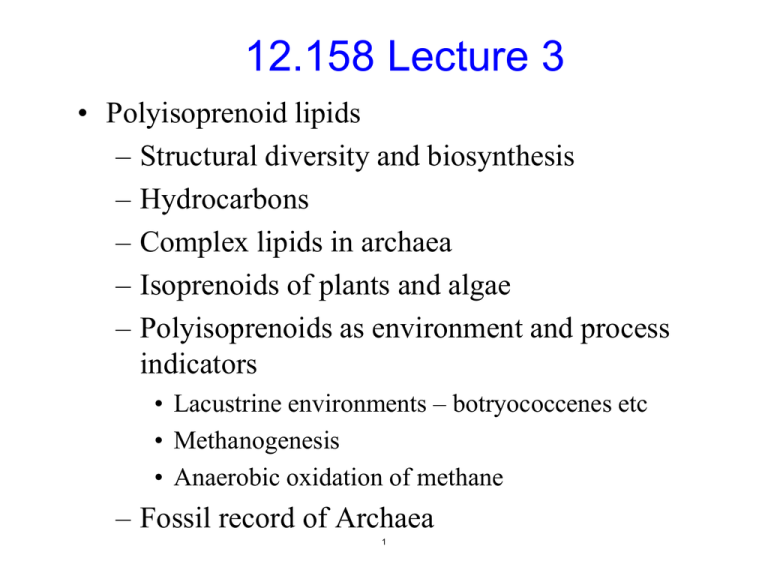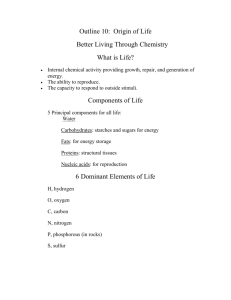
12.158 Lecture 3
• Polyisoprenoid lipids
– Structural diversity and biosynthesis
– Hydrocarbons
– Complex lipids in archaea
– Isoprenoids of plants and algae
– Polyisoprenoids as environment and process
indicators
• Lacustrine environments – botryococcenes etc
• Methanogenesis
• Anaerobic oxidation of methane
– Fossil record of Archaea
1
2- carbon molecule be the major building block for the complex 27- carbon, 4- ringed structure of the
cholesterol molecule?
BLOCH, LYNEN, AND THE CORNFORTH / POPJAK TEAM
In the late 1930s, another young Jewish émigré from Germany, Konrad Bloch, joined Clarke‟s
department as a graduate student. Bloch had already completed most of his thesis research at the University
of Basel and had published two papers on that research. Still, the Basel faculty rejected it as
“insufficient” (10). Bloch many years later learned that only one examiner on his committee had objected and
that was on the grounds that the thesis failed to cite some important references – papers authored by
that examiner! Looking back, Bloch realized that this may have been providential. Had he passes he decided to
stay on in Germany. At any rate, when Bloch came to New York in 1936, Clarke, a guardian angel to refugee
scientists, admitted him to his program and the Ph.D. was awarded about 2 years later. At that point,
Schoenheimer offered a Bloch position in his
2
3
Courtesy of the National Library of Medicine.
4
5
Courtesy of the National Library of Medicine.
Common Acyclic Isoprenoids
isoprene
head-to-tail
1
tail-to-tail
phytol
head-to-headphytane
1
OH
crocetane
pristane
1
2,6,10,15,19-pentamethylicosane (PMI)
1
2,6,10,14,18-pentamethylicosane
1
squalane
6
farnesane
Less Common Acyclic Isoprenoids
C30 HBI
C20 HBI
C25 HBI
Diatom sources
botryococcane
Botryococcus braunii
17
16 1
18
2
3
4
5
19
6
7
8
2'
9
Probable algal hydrocarbon lycopane
? from lycapodiene
7
lycopene
tomato carotenoid
Polar Lipid Precursors of Acyclic Isoprenoids
O
O
OH
phytane
archaeol
HO
caldarchaeol
O
O
O
O
OH
biphytane
O
O
O
OH
chrenarchaeol
O
HO
8
Stereochemistry of
archaeal and bacterial
lipids
9
33
34
35
36
10
Polar Lipid Precursors of Acyclic Isoprenoids
Common head groups of bacteria and archaea
H2N
O
P
O O
OH
O
OH
P
OH
O O
OH
ethanolamine (PE)
glycerol (PG)
O
NH2 P
OH
O O
OH
O
N
serine (PS)
choline (PC)
O R
O R
O
O
di-ester
O
O
R
O
R
di-ether
O
O
R
O R
O
mixed
OH
aminopentanetetrol (APT)
OH O
P
HO
O O
O
HO OH
HO
inositol (PI)
HO
HO
O
O
HO OH
hexose (archaea)
Common core lipids of archaea
CCommon
ommon core lilipids
pids of bacte
ria
bacteria
bacteri
O
O
P
O O
HO
OH
OH NH2
O
P
O OO
O
O
O
Archaeol
11
O
O
O
O
O
Caldarchaeol
O
Favored Mass Spectrometric Fragmentations
57
253
x50
267
71
323
85
127
183
??
12
352
Crocetane – Phytane Distinction
crocetane
phytane
crocetane
phytane
GC-FID
(a) 282-169; 0.6%, 1.9
Full Scan
(RIC)
(b) 196-127; 100%, 2.1
169 Da
(RIC from FS)
(c) 196-126; 63%, 2.3
169 Da (SIR)
(d) 168-182; 13%, 11.7
183 Da (SIR)
GC and GC-MS (SIR)
(e) 182-127; 40%, 0.1
GC-MS-MS
13
Crocetane – Phytane Distinction
14
Regular C25 vs PMI Distinction
Ace Lake Modern
Sed.PMI
Wilkinson 1
C25 reg
100%
C25 reg
100%
(a) 266-197 Da
100%
(a)
(a)
68%
2.4%
(b) 252-197 Da
76%
(b
)
(b)
26%
26%
4%
(c)
(c) 352-267 Da
35.48
W. Terrace
1
36.18
(c)
35.48
36.18
Ret. Time (mins)
One thin peak+ one compound
35.48
All fat peaks = more than one compound
15
36.18
Regular C25 vs PMI & HBI Distinction
O
R
O
O
2,6,10,14,14-pentamethylicosane
Carbon chains of Halobacterium core lipid
2,6,10,15,19-pentamethylicosane (PMI)
Found as a free hydrocarbon in some methanogens
A „highly branched isoprenoid‟ (HBI)
from a diatom
16
I25 Reg
PMI
Unknowns
1
2
(a) Monterey
(b) Byilkaoora-3
Distinguishing C25
Isoprenoids
note peak shapes
(c) Monterey + Byilkaoora-3
(d) W. Terrace-1
Partial 183Figure
Da (SIR)
6 chromatograms of (a) Monterey Formation showing elution position of
PMI; (b) Byilkaoora-3 showing elution position of I25 reg; (c) Monterey + Byilkaoora-3
mixture showing relative elution order of PMI and I25 reg isomers (NB. only partially
resolved); (d) West Terrace-1 which has a peak at the same position as the I25 reg isomer
and no peak at the earlier retention time of PMI. Unknown peaks 1 (Monterey) and 2 (West
Terrace-1) elute after I25 reg. Chromatogram 17time range = 36 sec.
phytane
reduction/dehydration/reduction
OH
E-3, 7R, 11R, 15-tetramethylhexadec-2-enol = phytol
oxidation/decarboxylation/reduction
=
6(R), 10(S) - pristane
6(S), 10(R) - pristane
6(R), 10(R) - pristane
6(S), 10(S) - pristane
18
Pristane to Phytane Ratio Pr/Ph
• An empirical parameter that was originally
used to classify Australian oils; high in oils
from land plant OM (Powell & McKirdy,
1973)
• Empirical correlation with depositional
environment (Didyk et al., 1978)
– <1 strongly reducing or evaporitic
environments (correlates with Gammacerane)
– 1-4 reducing marine and lacustrine environments
– >4 terrestrial aquatic environments
d13C of Pr and Ph generally similar
• Pr/Ph probably reflects redox control on
diagenesis of phytol
19
40.0
35.0
Kangaroo Is. Strand
OB
OA
Sawpit
Bass
GA1
GA2
GB Migr
%C27 Sterane
30.0
25.0
20.0
15.0
10.0
5.0
0.0
0.0
2.0
4.0
6.0
Pristane/Phytane
20
8.0
10.0
12.0
1.0
0.9
Bonaparte/Petrel
Bonaparte/Timor
Bonaparte/Vulcan
Canning
Carnarvon/Barrow
Carnarvon/Dampier
Carnarvon/Beagle
Carnarvon/Exmouth
Browse
Perth
Indo/Bintuni
Indo/Seram
Indo/Timor
0.8
nC27/nC17
0.7
0.6
0.5
0.4
0.3
0.2
0.1
0.0
0.0
1.0
2.0
3.0
4.0
Pr/Ph
21
5.0
6.0
7.0
Botryococcus
braunii
isoprenoids
22
C30 Botryococcene C31-C33 Botryoccanes
C30
C31
C32
C33
C33
23
some cultured B braunii strains
434
350
350
434
266
350
434
lake sediments (Maoming) and
Oils (Duri of Sumatra)
182
lake sediments (Maniguin) and
Oils (Minas and Duri of Sumatra)
210
294
24
Text has been removed due to copyright restrictions.
Please see: Abstract, John K. Volkman, et al. "C25 and C30
Highly Branched Isoprenoid Alkenes in Laboratory Cultures of
Two Marine diatoms." Organic Geochemistry 21, no.
3-4 (March-April 1994): 407-414.
25
Courtesy Elsevier, Inc., http://www.sciencedirect.com. Used with permission.
26
Courtesy Elsevier, Inc., http://www.sciencedirect.com. Used with permission.
Science 23 April 2004:
Vol. 304. no. 5670, pp. 584 – 587
The Rise of the Rhizosolenid Diatoms
Jaap S. Sinninghe Damsté,1* Gerard Muyzer,1,2 Ben Abbas,1 Sebastiaan W.
Rampen,1 Guillaume Massé,3 W. Guy Allard,3 Simon T. Belt,3 Jean-Michel Robert,4
Steven J. Rowland,3 J. Michael Moldowan,5 Silvana M. Barbanti,5,6 Frederick J.
Fago,5 Peter Denisevich,5 Jeremy Dahl,5 Luiz A. F. Trindade,6 Stefan Schouten1
The 18S ribosomal DNA molecular phylogeny and lipid
composition of over 120 marine diatoms showed that
the capability to biosynthesize highly branched
isoprenoid (HBI) alkenes is restricted to two specific
phylogenetic clusters, which independently evolved in
centric and pennate diatoms.
28
This image has been removed due to copyright
restrictions. Please see Figure 1 on
http://www.sciencemag.org/cgi/content/full/304/5670/584.
Fig. 1. Neighbor-joining phylogenetic tree based on
nearly complete 18S rRNA sequences of diatoms.
Some of the sequences were published before (5);
86 others (see table S1 for details) were determined
in this study. The sequences of Coccoid haptophyte
and Emiliania huxleyi were used as outgroups but
were pruned from the tree. Bolidomonas
mediterranea is a sister group of the diatoms. The
tree was created with the use of the Jukes Cantor
model. HBI-biosynthesizing strains are indicated in
red. Diatoms in green were tested but did not contain
HBI alkenes; diatoms in black were not tested for the
presence of HBI alkenes. The scale bar indicates
10% sequence variation. The inset shows the
structure of C25 HBI alkane (27) and parent skeleton
of C25 HBI unsaturated alkenes (7–11) produced by
diatoms. Note that the odd non HBI-biosynthesizing
Rhizosolenia strain, R. robusta, falls completely out
of the Rhizosolenia phylogenetic cluster, indicating
that its morphological classification as a
Rhizosolenia diatom is probably wrong.
29
Methane seeps:
Anaerobic oxidation of methane (AOM)
30
Image courtesy of Victoria Orphan. Used with permission.
Sediment Core from a methane-rich Monterey cold seep
This is a chemistry “profile” from the core
1200
800
600
400
200
0
1000
Methane (µM)
Depth into the sediment (cm)
0
CH 4
4
SO4
Bacteria feed on
methane and sulfate
8
12
16
0
5
Image courtesy of Victoria Orphan. Used with permission.
10
15
20
Sulfate (mM)
25
30
Anaerobic oxidation of methane
The “consortium hypothesis”
SO42-
CH4
Reversed
Methanogen
Intermediate
Product
SulfateReducing
Bacterium
CO2
HS-
Hoehler et al., Global Biogeochemical Cycles 8, 451-463 (1994)
Geochim. Cosmochim. Acta 62, 1745-1756 (1998)
32
NATURE |VOL 29 APRIL 1999 803
Text has been removed due to copyright restrictions.
Please see http://www.nature.com/nature/journal/v398/n6730/abs/398802a0.html.
33
Reconstructed-ion-current
chromatograms of
trimethylsilylated total lipid
extracts from (A) a sample
13±15 cm below the
sediment surface at a site of
active methane seepage (ERBPC26) and (B) a control sample
33±36 cm below the sediment
surface in the same basin but
remote from any site of methane
release (ERB-HPC5). Analytical
conditions for both sediment
extracts were identical (similar
amounts of extracted sediment,
identical dilutions prior injection
into the GC). Compound
1=archaeol, compound 2=sn-2hydroxyarchaeol.
This image has been removed due to copyright restrictions.
Please see Figure 1 on http://www.nature.com/nature/journal/
v398/n6730/full/398802a0.html.
34
Archaeal /
phy
Bacterial 16S rRNA methane seep
lotypes affiliated with AOM
ANME-2
DSS
ANME-1
Archaea
Image courtesy of Victoria Orphan.
Used with permission.
Bacteria
(Desulfosarcina)
modified from Orphan et al. (2001)
fish
36
Image courtesy of Victoria Orphan. Used with permission.
Archaeal / Bacterial 16S rRNA methane seep
phylotypes affiliated with AOM
ANME-2
Archaea
Image courtesy of Victoria Orphan.
Used with permission.
DSS
Bacteria
(Desulfosarcina)
Distribution of anaerobic methane-oxidizing consortia
ANME-2 / Desulfosarcina
Depth (cm)
Aggregates (107 x cm-3)
0 2
4 6 8
0
3
6
9
12
Hydrate Ridge, Oregon
15
Image courtesy of Victoria Orphan. Used with permission.
38
Up to 80% total biomass in sample
39
Image courtesy of Victoria Orphan. Used with permission.
12C /13C
40
Image courtesy of Victoria Orphan. Used with permission.
Heterogeneous composition of ANME-2 archaea
and Desulfosarcina in AOM aggregates
1.2 µm
3.6 µm
-50
-70
4.8 µm
7.2 µm
-100
Time (s)
Distance of ion
Depth profile ANME-2/DSS aggregate
beam penetration (µm)
1.2 µm optical sections (confocal)
41
Image courtesy of Victoria Orphan. Used with permission.
13C
compositions of archaeal lipids from
different marine sedimentary environments
AOM
OHEnvironment Archaeol archaeol Crocetane
Eel River Basin
Santa Barbara
Hydrate Ridge
Guaymas Basin
Kattegat
Mediterranean
mud volcanoes
-100
-119
-114
-81
---96
-106
-128
-133
-85
---77
-92
-119
-118
---100
-64
PMI
Phytanol
-92
-129
-214
1
---47
-91
-88
-120
---------
Hinrichs et al (1999); Hinrichs et al (2000); Boetius et al (2000);
Bian et al (1994); Pancost et al (2000); Orphan et al (2001);
Teske et al (2002)
42
APPLIED AND ENVIRONMENTAL MICROBIOLOGY, 0099-2240/01/$04.0010 DOI: 10.1128/AEM.67.4.1922
1934.2001 Apr. 2001, p. 1922–1934 Vol. 67, No. 4
Copyright © 2001, American Society for Microbiology. All Rights Reserved.
Comparative Analysis of Methane-Oxidizing Archaea and
Sulfate-Reducing Bacteria in Anoxic Marine Sediments
V. J. ORPHAN,1* K.-U. HINRICHS,2 W. USSLER III,1 C. K. PAULL,1 L. T. TAYLOR,1
S. P. SYLVA,2 J. M. HAYES,2 AND E. F. DELONG1*
Monterey Bay Aquarium Research Institute, Moss Landing, California 95039,1 and Department of Geology
and Geophysics, Woods Hole Oceanographic Institution, Woods Hole, Massachusetts 025432
Received 10 October 2000/Accepted 2 February 2001
The oxidation of methane in anoxic marine sediments is thought to be mediated by a
consortium of methane-consuming archaea and sulfate-reducing bacteria. In this study, we
compared results of rRNA gene (rDNA) surveys and lipid analyses of archaea and bacteria
associated with methane seep sediments from several
different sites on the Californian continental margin. Two distinct archaeal lineages (ANME-1
and ANME-2), peripherally related to the order Methanosarcinales, were consistently
associated with methane seep marine sediments. The same sediments contained abundant
13C-depleted archaeal lipids, indicating that one or both of these archaeal groups are members
of anaerobic methane-oxidizing consortia. 13C-depleted lipids and the signature 16S rDNAs for
these archaeal groups were absent in nearby control sediments. Concurrent surveys of
bacterial rDNAs revealed a predominance of d-proteobacteria, in particular, close relatives of
Desulfosarcina variabilis. Biomarker analyses of the same sediments showed bacterial fatty
acids with strong 13C depletion that are likely products of these sulfate-reducing bacteria.
Consistent with these observations, whole-cell fluorescent in situ hybridization revealed
aggregations of ANME-2 archaea and sulfate-reducing Desulfosarcina and Desulfococcus
species. Additionally, the presence of abundant 13C-depleted ether lipids, presumed to be of
bacterial origin but unrelated to ether lipids of members of the order Desulfosarcinales,
suggests the participation of additional bacterial groups in the methane-oxidizing process.
Although the Desulfosarcinales and ANME-2 consortia appear to participate in the anaerobic
oxidation of methane in marine sediments, our data suggest that other bacteria and archaea
are also involved in methane oxidation in these43environments.
Diverse archaeal/ bacterial associations
Eel River Basin
ANME-2
Unidentified
bacteria
ANME-2/Desulfosarcina/
Bacteria probes
DAPI (DNA stain)
44
Image courtesy of Victoria Orphan. Used with permission.
d13C METHANE
ANME-1
ANME-2
DIC
ANME-2
DESULFO SARC INA
FILAM ENTOUS
(S¼ OXID?) BACTERIA
UNIDENTIF IED SEEP
MICROORGANISM
d13C TO C
CH4
d13C DIC
-100
-80
-60
TOC
-40
d13C
45
Image courtesy of Victoria Orphan. Used with permission.
-20
0
Thiel V., Peckmann J., Seifert
R., Wehrung P., Reitner J., and
Michaelis W. (1999) Highly
isotopically depleted
isoprenoids: molecular
markers for ancient methane
venting. Geochim.
Cosmochim. Acta 63(23/24),
3959-3966.
Courtesy Elsevier, Inc.,
http://www.sciencedirect.com.
Used with permission.
46
Courtesy Elsevier, Inc.,
http://www.sciencedirect.com.
Used with permission.
47
Courtesy Elsevier, Inc., http://www.sciencedirect.com. Used with permission.
48
Science 21 February 2003:
Vol. 299. no. 5610, pp. 1214 - 1217
DOI: 10.1126/science.1079601
Molecular Fossil Record of Elevated Methane Levels in Late Pleistocene
Coastal Waters
Kai-Uwe Hinrichs, Laura R. Hmelo, Sean P. Sylva
Accumulating evidence suggests that methane has been released
episodically from hydrates trapped in sea floor sediments during many
intervals of rapid climate warming. Here we show that sediments from the
Santa Barbara Basin deposited during warm intervals in the last glacial
period contain molecular fossils that are diagnostic of aerobic and
anaerobic methanotrophs. Sediment intervals with high abundances of
these compounds indicate episodes of vigorous methanotrophic activity in
methane-laden water masses. Signals for anaerobic methanotrophy in
44,100-year-old sediment are evidence for particularly intense methane
emissions and suggest that the basin's methane cycle can profoundly
affect oxygen budgets in the water column.
49
This image has been removed due to copyright restrictions.
Please see caption on next page.
50
Fig. 1. Records of (A) carbon isotopic composition of benthic
(left) and planktonic (right) foraminifera (5) in comparison to
(B) abundance (left) and carbon isotopic composition (right)
of the molecular biomarker diplopterol (hopan-22-ol, structure
shown) in sediments deposited between 37 and 44.2 ka at
ODP Site 893 (14). Light-brown shading marks periods of
deposition of predominantly laminated sediments that
coincide with relatively warm interstadials (15). Purple
shading designates the four excursions in the carbon isotopic
record of planktonic foraminifera that had previously been
interpreted as evidence for particularly large releases of
methane (5). Benthic foraminifera are as follows: Bolivina
tumida, B. argentea, Uvigerina peregrina, Buliminella tenuata,
and Rutherfordoides rotundata.
51
This image has been removed
due to copyright restrictions.
52
Figure 2. Carbon isotopic
composition of the archaeal
ether lipid archaeol (structure
shown) in sediments
deposited 43 and 44.2 ka
(shading as in Fig. 1). The
minimum isotopic
composition of archaeol in
the 44.1-ka horizon indicates
contributions from
methanotrophic archaea. In
addition, three 13C-depleted
dialkylglycerolethers with
non-isoprenoidal alkyl
moieties, presumed to
represent bacterial members
of anaerobic methanotrophic
communities (16, 21), were
detected in this sample only
(fig. S1).
This image has been removed due to copyright restrictions.
Figure 2. Carbon isotopic composition of the archaeal etherlipid archaeol
(structureshown) in sediments deposited 43,000 and 44,200 years before present
(shading as in Figure 1). Concentrations of archaeol are uniform throughout this
interval (~ 150 ng/g dry sediment; data not shown). Like strongly 13C-depleted
archaeol, three dialkylglycerolethers were detected in the 44.1-kyr horizon only
53
(structural type shown).
MIT OpenCourseWare
http://ocw.mit.edu
12.158 Molecular Biogeochemistry
Fall 2011
For information about citing these materials or our Terms of Use, visit: http://ocw.mit.edu/terms.
54







